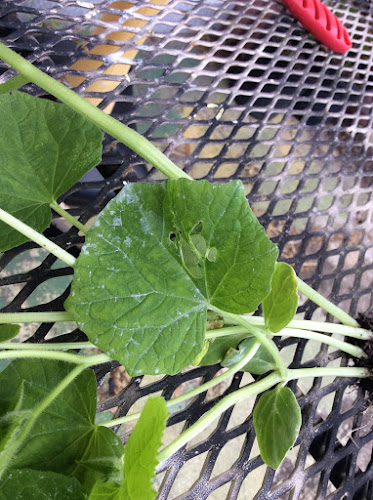A couple days ago I decided to pull out my corn plants. I had lost several already and the crop was in decline.
 |
| Corn dusted with DE |
 |
| Army worm damage |
I had applied at least three dustings of diatomaceous earth (DE) to try to kill of the army worm larva that were hiding in the whorls of the plant and in the soil during the day then would come out and munch the leaves at night.
 |
| Tiny destructive army worm |
All that trouble was caused by tiny army worms just a 1/4 to a half inch long. So I pulled the plants, tilled the soil, added vermicompost and planted some top bunch collards in the four square feet.
This morning I was checking on the garden and noticed what appeared to be powdery mildew on some of Sumter Cucumbers. I immediately pulled the plant out instead of trying to save the stunted plant.
 |
| Probably Powdery Mildew |
In spite of having planted the Sumter Cucumbers only a weekish after the Russian Cucumbers, the Sumters were less than a third of the Russians and clearly failing to thrive.
This little cucumber with the yellowish leaves is a Sumter. It only has three large leaves and is only up to the second rung of the tomato cage. It was the largest of my Sumters.
These big healthy cucumber plants are the Russians. You can see they have grown taller than the tomato cages, even outgrowing the vigorous sunflowers, and they are setting flowers.
A closer inspection of the plants roots reveals the reason for the Sumters failing health.
The root system is barely developed. The squash family (cucurbits) are prolific rooters to feed the large plants so this again signals a problem.
 |
| Root Galling from RKN |
An even closer look shows why. Notice the round bumpy nodule like roots? Those bumps are called galls. They are caused by the plant trying to protect itself from the infamous pest of sandy soils, the Root Knot Nematode (RKN). Most vegetables are susceptible to injury from this bugger. I would say the Nightshades (tomatoes, Eggplant, Peppers, white Potatoes) are the most susceptible, but Cucurbits are also affected. The RKN is a microscopic soil dwelling round worm that feeds off the juices in the roots of plants. Plants form galls in an attempt to isolate the RKN, but ultimately the roots are damaged and stunted. This leaves the plant malnourished, thirsty and vulnerable to attack from disease and other pests that an otherwise healthy plant may be able to cope with.
 |
| Root Galling from RKN |
The Sumter variety of cucumbers must be particularly vulnerable to attack. The last three or four times I've attempted to grow them I haven't had good results and only a couple, if any, cucumbers. Thinking back to the first time I grew them and was rewarded with dozens of cucumbers from just a few lively plants, I can easily pin point the reason for my success.
I had just made a brand new square foot garden following the Mel Bartholomew's method exactly. I had made 6" deep beds set on top of plastic landscape fabric and filled with NEW dirt made of 1/3 peat moss, 1/3 vermiculite and 1/3 compost and started the garden in early Spring. So guess what that meant? There were NO RKNs hiding in my garden soil. Of course inevitably they did migrate in and that soil began yielding poorer and poorer results. I blamed this on the shallow soils inability to hold water in our sunny hot humid climate. This I'm sure was partially true. But the constant decline of my plants was surely due to RKN damage.
I fear that I have greatly underestimated this nemesis over the years and may have blamed some of my garden's troubles too much on other problems. I will not be making that mistake again.
So where to go from here?
Well, I will be focussing my efforts on plant varieties that are RKN resistant in the future. This will be an all around boon as the plants will need less water and less fertilizer to compensate for the damaged roots. So no more Sumter Cucumbers. I am curious to see if at the end of the season my Russian Pickling Cucumbers have less galling of the roots and may be a RKN resistant variety. Their vigor suggests this may be the case.
Will I toss all my seeds that aren't RKN resistant? No. But if I really want to grow them, I'm going to have to look at container gardening with fresh store bought dirt every growing season (big sigh). So I'll limit myself to just a couple crops that I really want, but need the special treatment. This will probably be my Nightshades. And I may transition some of them out when I run out of seeds and in the future use RKN resistant varieties only.















































